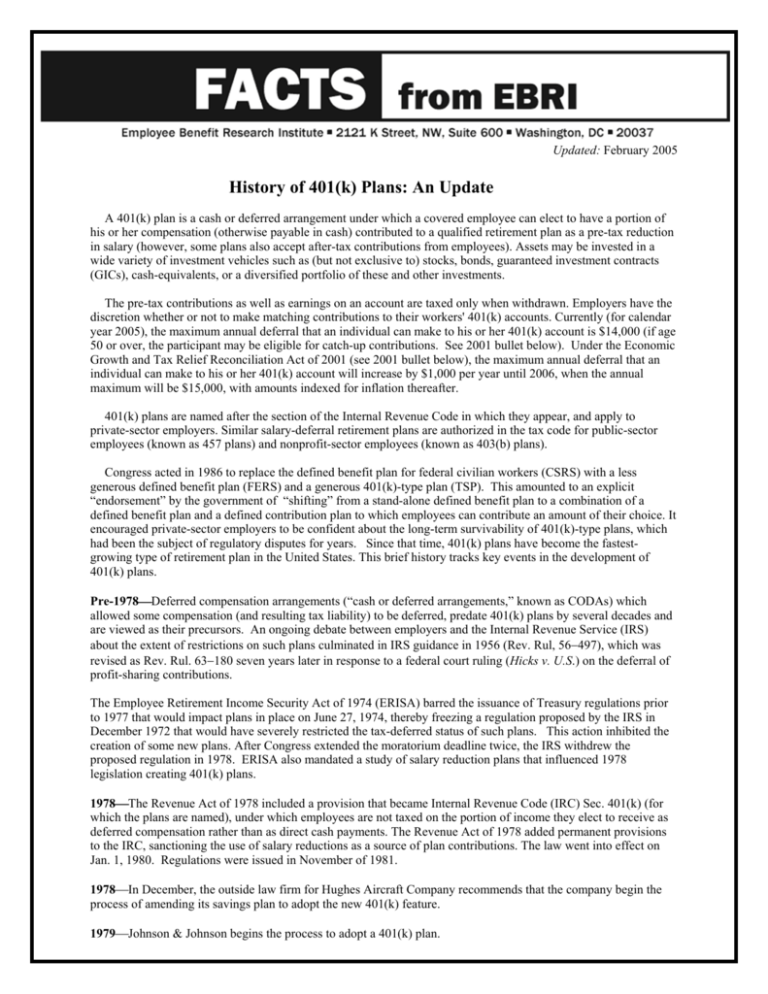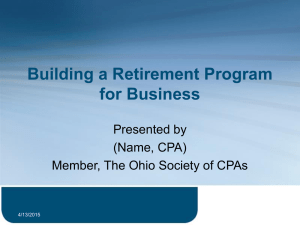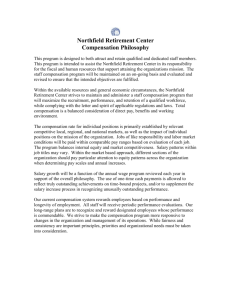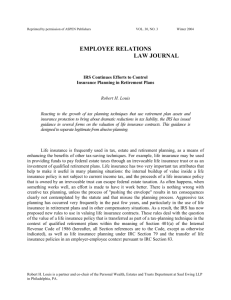History of 401(k) Plans: An Update
advertisement

Updated: February 2005 History of 401(k) Plans: An Update A 401(k) plan is a cash or deferred arrangement under which a covered employee can elect to have a portion of his or her compensation (otherwise payable in cash) contributed to a qualified retirement plan as a pre-tax reduction in salary (however, some plans also accept after-tax contributions from employees). Assets may be invested in a wide variety of investment vehicles such as (but not exclusive to) stocks, bonds, guaranteed investment contracts (GICs), cash-equivalents, or a diversified portfolio of these and other investments. The pre-tax contributions as well as earnings on an account are taxed only when withdrawn. Employers have the discretion whether or not to make matching contributions to their workers' 401(k) accounts. Currently (for calendar year 2005), the maximum annual deferral that an individual can make to his or her 401(k) account is $14,000 (if age 50 or over, the participant may be eligible for catch-up contributions. See 2001 bullet below). Under the Economic Growth and Tax Relief Reconciliation Act of 2001 (see 2001 bullet below), the maximum annual deferral that an individual can make to his or her 401(k) account will increase by $1,000 per year until 2006, when the annual maximum will be $15,000, with amounts indexed for inflation thereafter. 401(k) plans are named after the section of the Internal Revenue Code in which they appear, and apply to private-sector employers. Similar salary-deferral retirement plans are authorized in the tax code for public-sector employees (known as 457 plans) and nonprofit-sector employees (known as 403(b) plans). Congress acted in 1986 to replace the defined benefit plan for federal civilian workers (CSRS) with a less generous defined benefit plan (FERS) and a generous 401(k)-type plan (TSP). This amounted to an explicit “endorsement” by the government of “shifting” from a stand-alone defined benefit plan to a combination of a defined benefit plan and a defined contribution plan to which employees can contribute an amount of their choice. It encouraged private-sector employers to be confident about the long-term survivability of 401(k)-type plans, which had been the subject of regulatory disputes for years. Since that time, 401(k) plans have become the fastestgrowing type of retirement plan in the United States. This brief history tracks key events in the development of 401(k) plans. Pre-1978⎯Deferred compensation arrangements (“cash or deferred arrangements,” known as CODAs) which allowed some compensation (and resulting tax liability) to be deferred, predate 401(k) plans by several decades and are viewed as their precursors. An ongoing debate between employers and the Internal Revenue Service (IRS) about the extent of restrictions on such plans culminated in IRS guidance in 1956 (Rev. Rul, 56−497), which was revised as Rev. Rul. 63−180 seven years later in response to a federal court ruling (Hicks v. U.S.) on the deferral of profit-sharing contributions. The Employee Retirement Income Security Act of 1974 (ERISA) barred the issuance of Treasury regulations prior to 1977 that would impact plans in place on June 27, 1974, thereby freezing a regulation proposed by the IRS in December 1972 that would have severely restricted the tax-deferred status of such plans. This action inhibited the creation of some new plans. After Congress extended the moratorium deadline twice, the IRS withdrew the proposed regulation in 1978. ERISA also mandated a study of salary reduction plans that influenced 1978 legislation creating 401(k) plans. 1978⎯The Revenue Act of 1978 included a provision that became Internal Revenue Code (IRC) Sec. 401(k) (for which the plans are named), under which employees are not taxed on the portion of income they elect to receive as deferred compensation rather than as direct cash payments. The Revenue Act of 1978 added permanent provisions to the IRC, sanctioning the use of salary reductions as a source of plan contributions. The law went into effect on Jan. 1, 1980. Regulations were issued in November of 1981. 1978⎯In December, the outside law firm for Hughes Aircraft Company recommends that the company begin the process of amending its savings plan to adopt the new 401(k) feature. 1979⎯Johnson & Johnson begins the process to adopt a 401(k) plan. 1979-1982⎯Several companies, Johnson & Johnson, FMC, PepsiCo, JC Penney, Honeywell, Savannah Foods & Industries, Hughes Aircraft Company, and Coates, Herfurth, & England (a San Francisco-based consulting firm) develop 401(k) plan proposals, many of which officially began operation in January 1982. 1981⎯The IRS issued proposed regulations on 401(k) plans that sanctioned the use of employee salary reductions as a source of retirement plan contributions. Many employers replaced older, after-tax thrift plans with 401(k)s and added 401(k) options to profit-sharing and stock bonus plans. Within two years, surveys showed that nearly half of all large firms were either already offering a 401(k) plan or considering one. Dow Jones Industrial Average at yearend: 875.00. 1984⎯The Tax Reform Act of 1984 (TRA '84) modified the rules for 401(k) plans by, among other things, requiring “nondiscrimination” testing to ensure that contributions under tax-qualified plans do not discriminate in favor of highly compensated employees by more than an allowable amount. Number of plans with a 401(k) feature (according to U.S. Department of Labor Form 5500 reports): 17,303. Number of active participants in these plans: 7,540,000. Total assets in these plans: $91.75 billion. 1986⎯The Tax Reform Act of 1986 (TRA '86) tightened the nondiscrimination rules and reduced the maximum annual 401(k) before-tax salary deferrals by employees (under IRC Sec. 402(g)). It required all after-tax contributions to defined contribution plans to be included as annual additions under IRC Sec. 415 limits (which set the maximum annual addition that can be made to defined contribution plans). Prior to TRA ’86, after-tax contributions beyond 6 percent were included in IRC Sec. 415 limits. 1990⎯Number of plans with a 401(k) feature: 97,614. Number of active participants in these plans: 19,548,000. Total assets in these plans: $384.85 billion. 1992⎯The Unemployment Compensation Amendments of 1992 imposed a 20 percent mandatory withholding tax on lump-sum distributions that are not rolled over into another qualified retirement plan, annuity, or individual retirement account (IRA); liberalized rollover rules; and required plan sponsors to transfer eligible distributions directly to an eligible plan if requested by the participant. 1996⎯The Small Business Job Protection Act of 1996 (SBJPA) provided design-based “safe harbor” methods for satisfying the nondiscrimination tests applicable to 401(k) plans; introduced SIMPLE plans (savings incentive match plans for employees) for employers with 100 or fewer employees; repealed Sec. 415(e) limits that would reduce the amount that could be contributed to defined contribution plans⎯including 401(k) plans⎯if the employer also sponsored a defined benefit plan for the same employees; and greatly simplified the definition of "highly compensated employees." Number of plans with a 401(k) feature: 230,808. Number of active participants: 30,843,000. Total assets: $1.06 trillion. 1998⎯IRS issued Rev. Rul. 98−30, which gave a stamp of approval for employers to make “negative elections” (i.e., automatic enrollment) into 401(k) plans for newly eligible employees (“negative election” allows workers to be automatically enrolled in their employer's retirement savings plan if they take no action). Number of plans with a 401(k) feature: 300,593. Number of active participants: 37,114,000. Total assets: $1.54 trillion. 2000⎯IRS Rev. Rul. 2000−8 provided additional guidance on “negative elections” by allowing automatic enrollment in 401(k) plans for already-eligible employees who are deferring at a rate that is less than the automatic enrollment rate. 2001—The Economic Growth and Tax Relief Reconciliation Act of 2001 (EGTRRA) enacted many changes to 401(k) plans: • Increased elective annual deferral limits for 401(k), 403(b), and 457 plans to $11,000 in 2002, $12,000 in 2003, $13,000 in 2004, $14,000 in 2005, $15,000 in 2006, and indexed amounts to inflation thereafter. • Allowed additional “catch-up” contributions to 401(k), nonprofit 403(b), and governmental 457(b) plans by participants age 50 and older, up to $1,000 in 2002, $2,000 in 2003, $3,000 in 2004, $4,000 in 2005, 2 • • • • • • • $5,000 in 2006, and indexed thereafter. Increased the maximum compensation limit (as a percentage of salary) to $200,000 from $170,000, and amounts are indexed thereafter. Increased the 415(c) defined contribution dollar limit to $40,000 from $35,000, indexed thereafter in $1,000 increments. In addition, the 415(c) compensation limit is increased to 100 percent of compensation, up from 25 percent at the time EGTRRA was passed. Required faster vesting requirements of employer matching contributions made for plan years beginning after 2001 (the chosen schedule must vest at least as rapidly as three-year cliff vesting, or two- to six-year graded vesting). Retroactively reinstated a special 401(k) coverage testing rule, whereby a “controlled group” includes both tax-exempt and taxable employers. Allowed rollovers of contributory IRA amounts into 401(k), 403(b), 457(b) plans, or other IRAs. Repealed the “same desk” rule for 401(k), 403(b), and 457(b) plans by replacing “separation from service” in Sec. 401(k)(2)(B) with “severance from employment.” Required all mandatory cashouts of more than $1,000 (up to the current $5,000 maximum) to be rolled over to an IRA, unless the participant elects otherwise. These provisions are to take place within three years after the date of enactment, which was Jan. 1, 2002. Beginning in 2003, 401(k) plans will be allowed to “facilitate” IRA contributions in addition to 401(k) contributions for eligible employees. Beginning in 2006, 401(k) and 403(b) plans will be permitted to allow participants to designate a portion of their elective deferral to become after-tax “Roth contributions.” 2002—Congress enacted the Sarbanes-Oxley Act of 2002 (also known as the Corporate and Auditing Accountability Responsibility and Transparency Act of 2002), P.L. 107−204, in response to the Enron and WorldCom corporate accounting scandals. This law includes two major provisions affecting 401(k) plans: • Blackout Periods⎯So-called “insider trades” by corporate executives in their nonqualified retirement plans are prohibited during trading blackout periods when administrators are being changed in a sponsor’s qualified individual account retirement plan. The law provides that profits realized from such trades shall inure to and be recoverable by the issuer irrespective of the intent of the parties to the transaction. • Disclosure⎯Plan administrators are required to provide 30-day advance notice to participants and beneficiaries of individual account plans prior to the imposition of a trading blackout. Plan administrators are subject to civil penalties for failure to notify. Estimated number of plans with a 401(k) feature: 423,000. Estimated number of active participants in these plans: 43.0 million. Estimated total assets in these plans: $1.81 trillion. 2003—As of year-end 2003, estimated number of plans with a 401(k) feature: 438,000, with total assets estimated to be $1.9 trillion and 42.4 million active participants. For more information, contact Ken McDonnell, (202) 775-6300, or see EBRI's Web site at www.ebri.org. Source: Employee Benefit Research Institute, Databook on Employee Benefits, 4th Edition (Employee Benefit Research Institute, 1997); Washington Bulletin, May 30, 2001 (Employee Benefit Research Institute, 2001); “Toward a More Complete 401(k) History”, EBRI Notes, vol. 24, no. 12, December 2003; Congressional Research Service summary of H.R. 3763, P.L. 107−204 (Sarbanes-Oxley Act of 2002), posted on the Web at http://thomas.loc.gov/cgi-bin/bdquery/z?d107:HR03763:@@@D&summ2=m& (last reviewed Oct. 1, 2002); and Cerulli Associates, The Cerulli Report: Retirement Industry Update: Trends in 401(k) and IRA Markets (Cerulli Associates, 2002). FS-187 2/05 3





